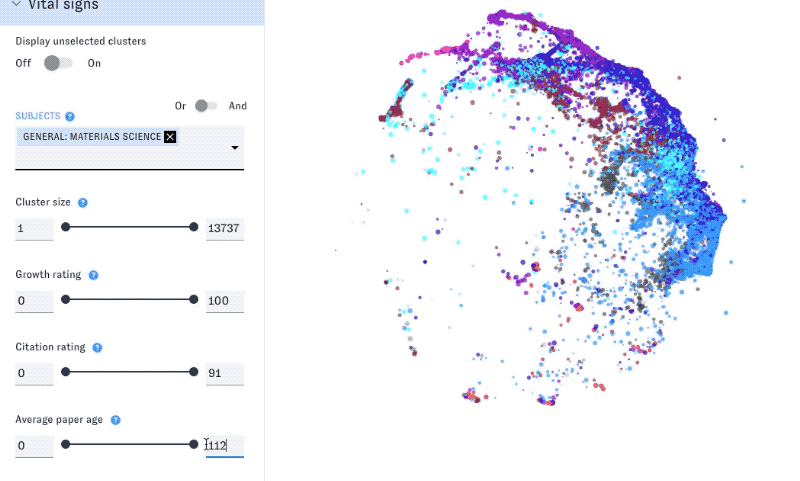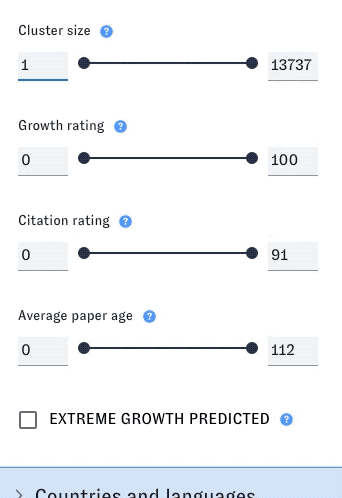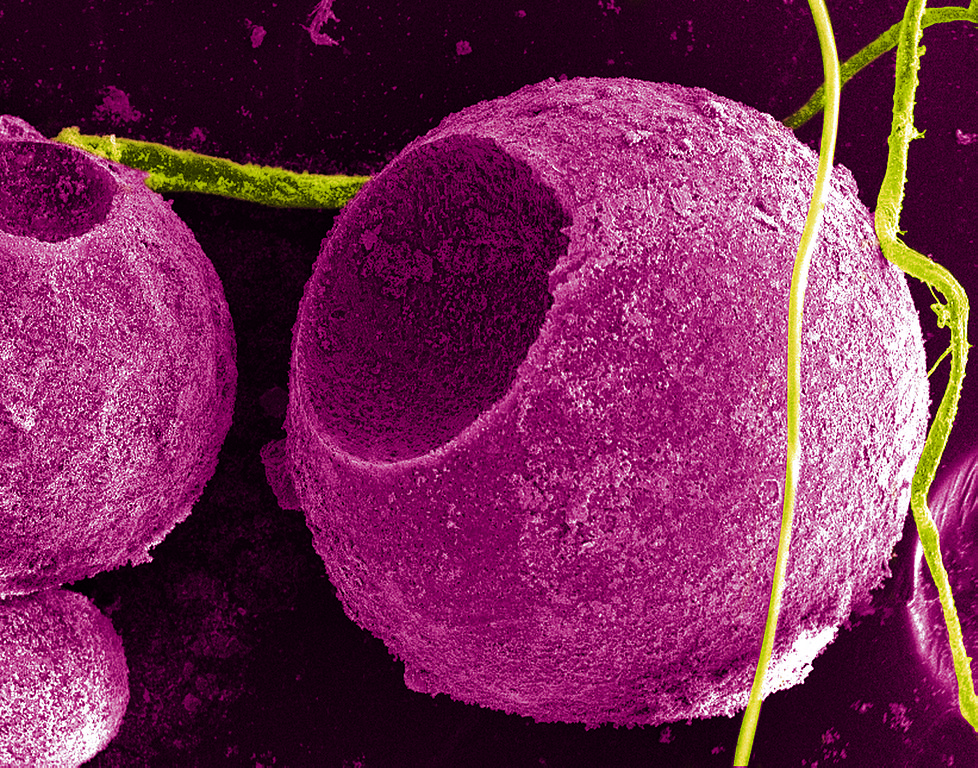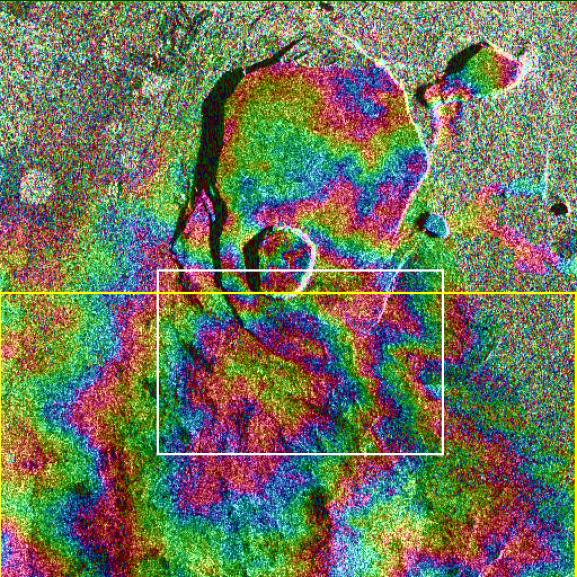ETO's Map of Science is designed to give users of different backgrounds, resources, and analytic perspectives an accessible way to explore global research. To achieve this mission, we combined powerful methods for merging, processing, and enriching hundreds of millions of research articles with a flexible, intuitive interface.
The Map of Science helps users quickly find specific areas in science and tech that matter to them, starting from broad questions like:
- Which research areas are growing the fastest?
- Which types of research are having the biggest impact?
- What are researchers in particular countries publishing on?
To show how the Map can help turn questions like these into actionable insight, we recently took it on a test drive through five different domains of science and technology: materials science, quantum research, computing and networking hardware, Chinese AI research, and pharmacology. Within each domain, we applied filters in the Map to identify especially "hot" topics, each represented by a specific research cluster –– a group of articles that cite each other unusually often, typically because they share traits like subject matter, author, language, or authoring institution. (Read more about research clusters and how we identify them.)
The Map of Science organizes the global research literature into tens of thousands of these clusters, which can then be filtered and sorted with the Map's user-friendly interface to pinpoint research of greatest interest.

For our "hot topics" exploration, we looked for research clusters in each of the five broad domains that were:
- Large: containing 100 articles or more, reflecting an active area of research.
- Young: with an average article age of five years or under, reflecting lots of recent activity.
- Fast-growing: adding new papers faster than most other clusters in the Map.
- Impactful: whose articles were cited frequently, compared to articles in other clusters in the Map.
What we found
The Map's interface includes filters for each of these characteristics. By combining them with the Map's subject-matter filters, a single, non-expert analyst (your narrator) was able to quickly zero in on especially interesting areas.

The earlier entries in our Hot Topics series have more details for the five different domains of research we explored. Here are some highlights, with full results for each domain listed at the end of this post.
Materials science
- Thousands of articles on or related to zinc-ion batteries have been published in the past few years alone.
- Government-affiliated researchers seem to be interested in high-entropy ceramics. Top authoring institutions in this fast-growing area include the Chinese Academy of Sciences, Oak Ridge National Laboratory, and Northwestern Polytechnical University (a Chinese military-affiliated university).
- Laser-induced graphenes are attracting attention for their uses in applications including wearable technology and alternative energy.
👉 Read the post: What's hot in materials science? Discovering emerging topics with ETO's Map of Science

Quantum
- Toronto seems to be a hub of research into using machine learning to analyze quantum phenomena.
- Similarly, the University of Technology Sydney is associated with a large number of articles about single-photon emitting materials.
- Other active areas include topological semimetals, quantum computing algorithms, and (especially among Indian researchers) tungsten and molybdenum disulfide quantum dots.
👉 Read the post: What's hot in quantum? Discovering emerging topics with ETO's Map of Science

Computing and networking hardware
- Reconfigurable reflecting surfaces for wireless communication are attracting major attention. We found a cluster on this topic that was extremely large (over 3000 articles in the past five years) and growing extremely fast (99th percentile in the Map), an unusual combination.
- Several Chinese institutions are conducting lots of research into using drones as wireless networking infrastructure.
- We also found an interesting cluster of research focused on magnetic tunnel junctions in computing hardware. Purdue University was the clear leader in this cluster (53/238 articles were associated with a Purdue author).
👉 Read the post: What's hot in hardware? Discovering emerging topics with ETO's Map of Science
Chinese AI research
- Chinese-affiliated authors have written thousands of recent articles on using AI to detect faults in machinery.
- Research clusters related to skeleton-based action recognition and machine learning in MIMO communications were associated with large numbers of patents.
- Several notable clusters seemed focused on using AI to process remote sensing data (for example: hyperspectral image processing, scene classification).
👉 Read the post: What's hot in Chinese AI research? Discovering emerging topics with ETO's Map of Science

Pharmacology
- Indian authors were especially prominent in one active coronavirus-related research cluster, with many articles on COVID-fighting protease inhibitors.
- A smaller but rapidly growing cluster of research focused on using magnetic nanoparticles in cancer treatment.
- U.S. and Japanese authors are working on near-infrared photoimmunotherapy for cancer, and Japanese authors, institutions, and funders are also especially active in research into sodium-glucose co-transporter 2 inhibitors for diabetes and fatty liver disease.
👉 Read the post: What's hot in pharmacology? Discovering emerging topics with ETO's Map of Science
Hopefully, these quick examples help show how you can use the Map to efficiently explore the global research landscape –– and (once you have an approach that gives interesting results) how you can tweak it without too much trouble.
Of course, no single method or resource is perfect, and the Map of Science certainly has its limitations. We hope the Map will be a useful complement to other methods, not necessarily a replacement. On its own, the Map can provide good initial insight into many important questions about global science and technology. If you have access to subject-matter experts, scholarly datasets, or other such resources, so much the better. We believe the Map will make those resources moreuseful, not less, by helping you easily and efficiently scope your analysis, experiment with different perspectives on the landscape, and find interesting "entry points" for further investigation.
To start using the Map of Science, visit sciencemap.eto.tech. In the meantime, if you'd like to learn more about the Map, its capabilities, and its limitations, ETO is here to help: check out our blog posts or the Map's documentation, book a live support slot, or contact us directly.
Get updates
Full results
Materials science
Read the post: What's hot in materials science? Discovering emerging topics with ETO's Map of Science
| Cluster ID | What does this cluster seem to be about? (summary based on the cluster's keywords and top articles) | Number of articles (last 5 years) | Selected articles (selected from the "Articles and sources" pane in the cluster's detail view) | Other interesting features (based on information from the cluster's detail view) |
| 9380 | Zinc-ion batteries | 3620 | "Active Materials for Aqueous Zinc Ion Batteries: Synthesis, Crystal Structure, Morphology, and Electrochemistry" | Average article age is less than two years old; nearly 10 times as many Chinese-authored articles as U.S.-authored articles, but the U.S.-authored articles are cited about twice as often on average |
| 107248 | New uses of natural materials for pH-sensitive drug delivery - chitosan, alginate, graphene oxide, etc. | 102 | "pH-sensitive drug delivery based on chitosan wrapped graphene quantum dots with enhanced fluorescent stability" | Extremely rapid growth (99th percentile) |
| 43514 | High-entropy ceramics and their applications | 1002 | "Processing and Properties of High-Entropy Ultra-High Temperature Carbides" | Top three author institutions: Chinese Academy of Sciences, Oak Ridge National Laboratory, and Northwestern Polytechnical University (a Chinese military-affiliated university) |
| 48593 | Nanoparticles that fight viruses | 850 | "Functional Carbon Quantum Dots as Medical Countermeasures to Human Coronavirus" | 75 patents cite articles in this cluster (90th percentile among all clusters in the Map) |
| 81005 | Phosphors in near-infrared light sources | 341 | "Highly efficient and thermally stable Cr3+-activated silicate phosphors for broadband near-infrared LED applications" | 81% of the most recent articles (276/341) have Chinese authors |
| 2531 | "MXenes" (two-dimensional materials with unusual properties) - synthesis and application | 4461 | "Applications of 2D MXenes in energy conversion and storage systems" | Drexel University (Philadelphia, PA) leads the authorship table (267 articles in the last five years, 30.37 citations per article), followed by the Chinese Academy of Sciences (221 articles, 14.3 average citations per article) |
| 54445 | Using lasers to make graphene | 670 | "Laser-induced graphene for bioelectronics and soft actuators" | Frequently cited by articles in other clusters related to wearable sensors and alternative energy |
| 55310 | Transparent engineered wood | 664 | "Bioinspired Wood Nanotechnology for Functional Materials" | Top author countries: China, U.S., Sweden, Switzerland, Germany |
| 14501 | Hydrogel-based sensors with interesting properties | 2143 | "Mussel-inspired hydrogels as tough, self-adhesive and conductive bioelectronics: a review" | 57% (1216/2143) of the articles in this cluster were funded by China's National Natural Science Foundation |
Quantum
Read the post: What's hot in quantum? Discovering emerging topics with ETO's Map of Science
Cluster ID | What does this cluster seem to be about? (summary based on the cluster's keywords and top articles) | Number of articles (last 5 years) | Selected articles (selected from the "Articles and sources" pane in the cluster's detail view) | Other interesting features (based on information from the cluster's detail view) |
| 48420 | Single-photon emitting materials | 643 | "Quantum emitters in 2D materials: Emitter engineering, photophysics, and integration in photonic nanostructures" | One in six articles in this cluster (98/643) has an author from the University of Technology Sydney |
| 41709 | Using machine learning to analyze quantum phenomena | 828 | "Drawing Phase Diagrams of Random Quantum Systems by Deep Learning the Wave Functions" | Many authors are affiliated with institutions in Toronto (University of Waterloo, Perimeter Institute, Vector Institute) |
| 57676 | Quantum computing attacks on Feistel cryptographic structures and other ciphers | 462 | "Implementing Grover oracles for quantum key search on AES and LowMC" | 29 patents cite articles in this cluster |
| 2503 | Quantum computing algorithms | 3804 | "Noisy intermediate-scale quantum (NISQ) algorithms" | Top author organizations from industry: Google, Microsoft, IBM, Xanadu Quantum Technologies |
| 44652 | Detecting contaminants with quantum dot sensors | 442 | "A facile optosensing protocol based on molecularly imprinted polymer coated on CdTe quantum dots for highly sensitive and selective amoxicillin detection" | About half of articles (217/442) reported funding from a Chinese organization |
| 49998 | Applications of van der Waals heterostructures | 599 | "Van der Waals heterostructures for high-performance device applications: challenges and opportunities" | 91% of articles are in English, but the top ten author organizations are all East Asian |
| 44845 | Tungsten and molybdenum disulfide quantum dots | 504 | "WS Nanosheet/Graphene Heterostructures for Paper-Based Flexible Photodetectors" | Leading author country: India (206/504 articles) |
| 2781 | Topological semimetals | 2524 | "Extremely high conductivity observed in the triple point topological metal MoP" | Research is cited in patents for quantum computing, thermoelectric devices, far-infrared detection, hydrogen production |
Computing hardware
Read the post: What's hot in hardware? Discovering emerging topics with ETO's Map of Science
| Cluster ID | What does this cluster seem to be about? (summary based on the cluster's keywords and top articles) | Number of articles (last 5 years) | Selected articles (selected from the "Articles and sources" pane in the cluster's detail view) | Other interesting features (based on information from the cluster's detail view) |
|---|---|---|---|---|
| 77332 | Magnetic tunnel junction devices | 238 | "Integer factorization using stochastic magnetic tunnel junctions" "Neural-like computing with populations of superparamagnetic basis functions" | Purdue University leads the authorship table (53 articles in the cluster), followed by University of Central Florida (21) and Beihang University in China (9) |
| 81599 | Advanced wearable medical monitoring devices | 233 | "A 13.34W Event-Driven Patient-Specific ANN Cardiac Arrhythmia Classifier for Wearable ECG Sensors" "Design and Implementation of a Machine Learning Based EEG Processor for Accurate Estimation of Depth of Anesthesia" | 10% of articles are AI-related |
| 59431 | High-bandwidth optical transmitters | 385 | "400G and Beyond: Coherent Evolution to High-Capacity Inter Data Center Links" "A SiGe-HBT 2:1 analog multiplexer with more than 67 GHz bandwidth" | Over 30% of articles are from industry (top authoring companies: Huawei, Nokia, NTT) |
| 90867 | Hardware for posit arithmetic | 184 | "PACoGen: A Hardware Posit Arithmetic Core Generator" "Performance-Efficiency Trade-off of Low-Precision Numerical Formats in Deep Neural Networks" | 35% of articles are AI-related |
| 32414 | Localization and positioning applications of ultra-wideband networks | 735 | "UWB-based system for UAV Localization in GNSS-Denied Environments: Characterization and Dataset" "Applications of UWB Networks and Positioning to Autonomous Robots and Industrial Systems" | European authors and institutions lead the cluster |
| 19741 | Ambient backscatter communication | 1233 | "Exploiting Multiple Antennas for Cognitive Ambient Backscatter Communication" "Practical Backscatter Communication Systems for Battery-Free Internet of Things: A Tutorial and Survey of Recent Research" | 116 patents cite articles in this cluster (94th percentile among all clusters) |
| 13808 | Reconfigurable reflecting surfaces for wireless communication | 3590 | "Smart radio environments empowered by reconfigurable AI meta-surfaces: an idea whose time has come" "Intelligent Reflecting Surface Enhanced Wireless Network via Joint Active and Passive Beamforming" | Growing extremely fast (99th percentile among all clusters in the Map) |
| 3023 | Using drones as wireless networking infrastructure | 4547 | "Joint Trajectory and Communication Design for Multi-UAV Enabled Wireless Networks" "A survey on UAV placement optimization for UAV-assisted communication in 5G and beyond networks" | Top five author organizations are all Chinese: Beijing University of Posts and Telecommunications, Southeast University, Tsinghua University, Xidian University, PLA Army Engineering University |
| 5367 | Various neuromorphic devices | 3182 | "Fully hardware-implemented memristor convolutional neural network" "Recent Advances in Transistor-Based Artificial Synapses" | 92% of articles are in English, but the top ten author organizations are all East Asian |
Chinese AI research
Read the post: What's hot in Chinese AI research? Discovering emerging topics with ETO's Map of Science
| Cluster ID | What does this cluster seem to be about? (summary based on the cluster's keywords and top articles) | Share of articles with at least one author from a Chinese institution | Selected articles (selected from the "Articles and sources" pane in the cluster's detail view) | Other interesting features (based on information from the cluster's detail view) |
|---|---|---|---|---|
| 1989 | Graph neural networks (in general) | 50% (2646/5262) | "Deeper Insights into Graph Convolutional Networks for Semi-Supervised Learning" "How Powerful are Graph Neural Networks?" | Top three countries by article count: China (2646), U.S. (1474), Australia (300); the same countries ranked by citations (per-article yearly average): Australia (13.2), U.S. (10.17), China (3.93) |
| 19241 | Deep learning for hyperspectral image processing | 71% (1529/2139) | "Hyperspectral Image Classification With Deep Feature Fusion Network" "Advances in Hyperspectral Image Classification Based on Convolutional Neural Networks: A Review" | U.S.-affiliated authors published 67 articles in this cluster in 2021; 28 of them (42%) were collaborations with China-affiliated authors |
| 3568 | Machinery fault detection with AI | 77% (3910/5048) | "A deep convolutional neural network with new training methods for bearing fault diagnosis under noisy environment and different working load" "Applications of machine learning to machine fault diagnosis: A review and roadmap" | Almost a quarter of articles are solely in Chinese - an unusually high percentage |
| 13372 | Using machine learning in multiple-input/multiple-output wireless telecommunications | 51% (1212/2394) | "Machine Learning in the Air" "Deep Learning-based Channel Estimation for Beamspace mmWave Massive MIMO Systems" | 161 patents cite research in this cluster |
| 58382 | AI-based approaches to data fusion in remote sensing | 53% (249/468) | "Deep Encoder–Decoder Networks for Classification of Hyperspectral and LiDAR Data" "Identifying Corresponding Patches in SAR and Optical Images with a Pseudo-Siamese CNN" | Many articles in this cluster come from IEEE publications |
| 7227 | "Skeleton-based action recognition" | 56% (1206/2159) | "NTU RGB+D 120: A Large-Scale Benchmark for 3D Human Activity Understanding" "Skeleton-Based Action Recognition Using Spatio-Temporal LSTM Network with Trust Gates" | 211 patents cite articles in this cluster - sample title: "Method and system for recognizing emotions and actions" |
| 24615 | AI approaches to associating diseases with specific microRNA | 88% (1031/1165) | "A comprehensive survey on computational methods of non-coding RNA and disease association prediction" "Predicting miRNA-disease association based on inductive matrix completion" | Top author institution: China University of Mining and Technology (98 articles. 15.6 average yearly citations per article) |
| 63809 | Neuroimagery processing and diagnosis with AI | 66% (211/318) | "Unsupervised Manifold Learning Using High-Order Morphological Brain Networks Derived From T1-w MRI for Autism Diagnosis" "A toolbox for brain network construction and classification" | Leading author institutions are non-Chinese (Istanbul Technical Univesity, University of Dundee, UNC Chapel Hill), despite the heavy Chinese presence in the cluster as a whole |
| 13724 | Machine learning for scene classification in remote sensing imagery | 62% (1197/1939) | "PatternNet: A benchmark dataset for performance evaluation of remote sensing image retrieval" "Urban land-use mapping using a deep convolutional neural network with high spatial resolution multispectral remote sensing imagery" | Private companies associated with articles in this cluster include Lockheed Martin, Airbus, and several Chinese state-owned enterprises |
Pharmacology
Read the post: What's hot in pharmacology? Discovering emerging topics with ETO's Map of Science
| Cluster ID | What does this cluster seem to be about? (summary based on the cluster's keywords and top articles) | Number of articles (last 5 years) | Selected articles (selected from the "Articles and sources" pane in the cluster's detail view) | Other interesting features (based on information from the cluster's detail view) |
|---|---|---|---|---|
| 88560 | Using magnetic nanoparticles in hyperthermic cancer treatment | 163 | "Hadron Therapy, Magnetic Nanoparticles and Hyperthermia: A Promising Combined Tool for Pancreatic Cancer Treatment" "Nanoparticles exhibiting self-regulating temperature as innovative agents for Magnetic Fluid Hyperthermia" | Extremely rapid growth (100th percentile among all clusters in the Map) |
| 30068 | Akkermansia muciniphila probiotic bacteria | 1198 | "Akkermansia muciniphila: is it the Holy Grail for ameliorating metabolic diseases?" "Pasteurized Akkermansia muciniphila increases whole-body energy expenditure and fecal energy excretion in diet-induced obese mice" | Over half of articles in the cluster have Chinese authors, but they are cited significantly less often than articles from other countries |
| 10761 | COVID-19 protease-targeting drugs | 3073 | "Structural basis of SARS-CoV-2 3CL~(pro) and anti-COVID-19 drug discovery from medicinal plants" "Boceprevir, GC-376, and calpain inhibitors II, XII inhibit SARS-CoV-2 viral replication by targeting the viral main protease" | Top authoring country: India (757/3073 articles have at least one Indian author) |
| 68964 | Sodium-glucose co-transporter 2 inhibitors | 441 | "Empagliflozin Improves Liver Steatosis and Fibrosis in Patients with Non-Alcoholic Fatty Liver Disease and Type 2 Diabetes: A Randomized, Double-Blind, Placebo-Controlled Clinical Trial" "SGLT-2 Inhibitors in NAFLD: Expanding Their Role beyond Diabetes and Cardioprotection?" | Japanese authors, institutions and funders are especially prominent in this cluster |
| 85537 | Kinase inhibitor treatment for Alzheimer's disease | 160 | "Role of p38/MAPKs in Alzheimer's disease: implications for amyloid beta toxicity targeted therapy" "Simplified immunosuppressive and neuroprotective agents based on gracilin A" | Top author in this cluster, both by paper count and citations (39 average yearly citations per paper): Hyang-Sook Hoe of the Korea Brain Research Institute |
| 47700 | Ivermectin treatment for COVID-19 | 831 | "Meta-Analyses Do Not Establish Improved Mortality With Ivermectin Use in COVID-19" "Effect of Ivermectin on Time to Resolution of Symptoms Among Adults With Mild COVID-19: A Randomized Clinical Trial" | Top authoring institutions are predominantly British and Spanish |
| 76046 | Near-infrared photoimmunotherapy of cancer | 234 | "Endoscopic Applications of Near-Infrared Photoimmunotherapy (NIR-PIT) in Cancers of the Digestive and Respiratory Tracts" "Near-Infrared Photoimmunotherapy: Photoactivatable Antibody–Drug Conjugates (ADCs)" | The United States and Japan play leading roles in this cluster |
| 19657 | Drug delivery via extracellular vesicles | 1543 | "New approaches in extracellular vesicle engineering for improving the efficacy of anti-cancer therapies" "Engineering macrophage-derived exosomes for targeted paclitaxel delivery to pulmonary metastases: in vitro and in vivo evaluations" | Top venue for articles in this cluster, unsurprisingly: the Journal of Extracellular Vesicles |

